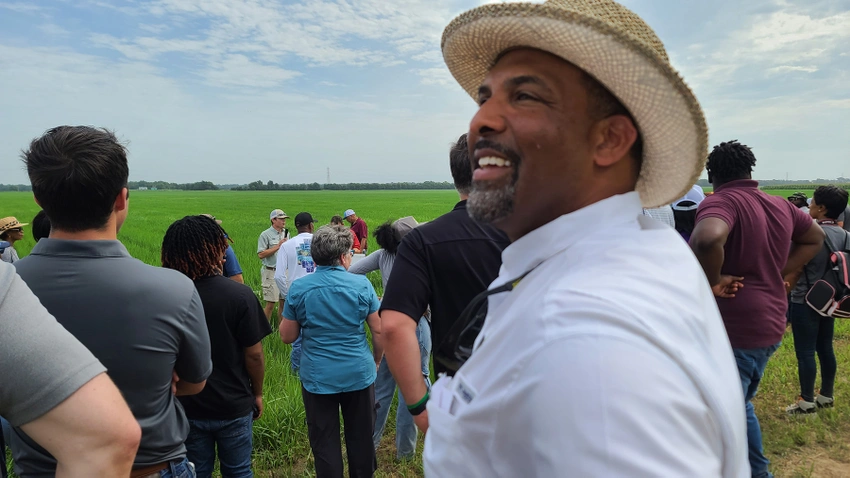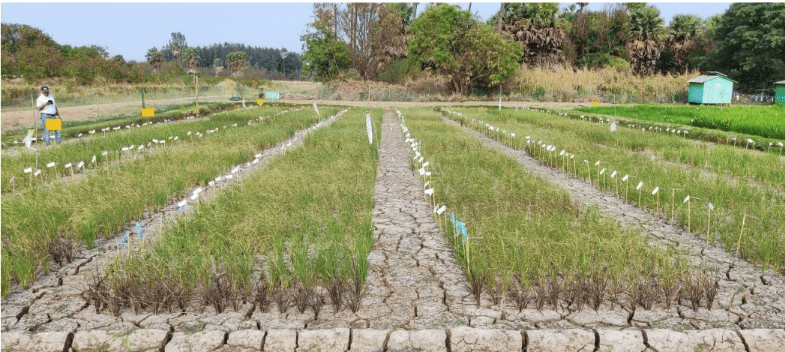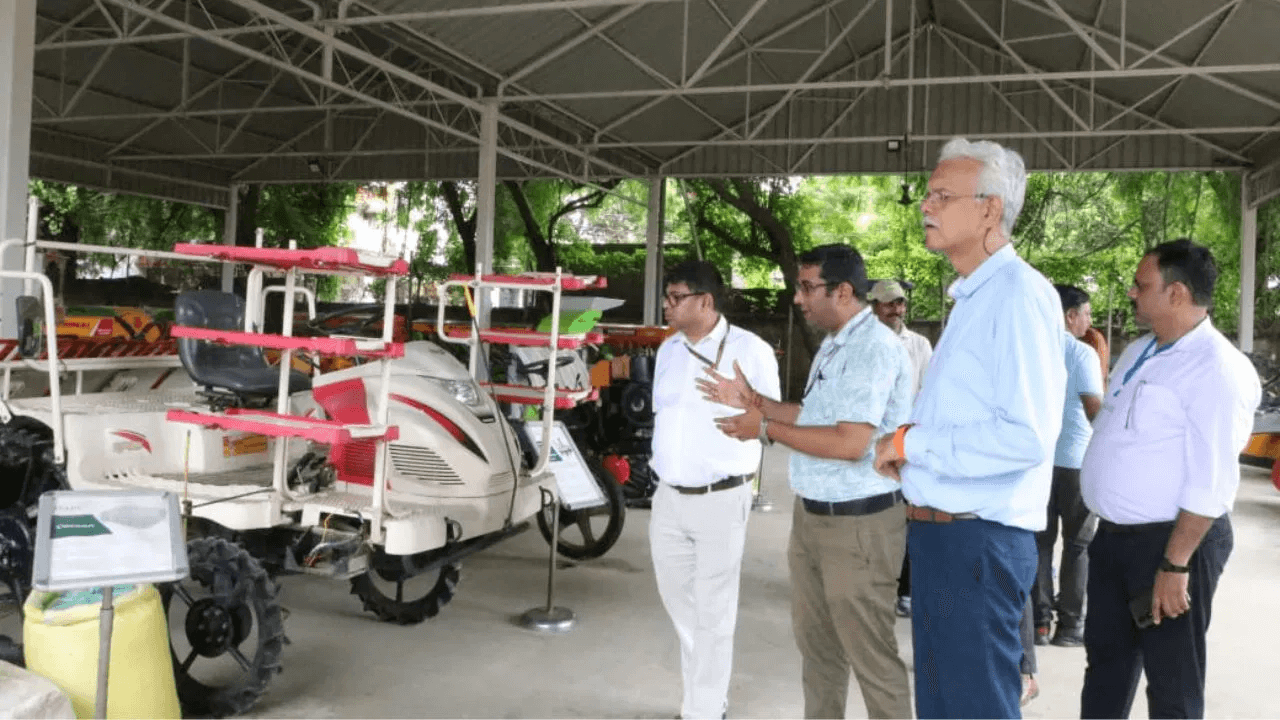Tags
Farmers complete first year of Climate-Smart rice project
P.J. Haynie and his family are participating in a USDA pilot project aimed at using Climate-Smart conservation practices.

P.J. Haynie (light shirt) visits with farmers attending a National Black Growers Council Field Day on one of his family’s farms in 2023. MICHAEL KLEIN, USA RICE FEDERATION
Some farmers are trying furrow-irrigated or row rice to see if they can use less water, a resource that is becoming more and more scarce in parts of the Midsouth.
P.J. Haynie and his family are growing row rice partly because their farming operation was not set up for growing conventional levee rice, but also because they’re part of a USDA pilot project aimed at using Climate-Smart conservation practices like row rice.
“It allows us to take some fields that aren’t zero grade, that aren’t 100% precision-leveled and grow rice on them, watering off the ridge with polypipe like we do with corn and beans,” said Haynie, whose family grew about 700 acres of row rice in 2023.
USDA’s Partnerships for Climate-Smart Commodities Program is providing an $80-million grant to the pilot project to “build climate-smart rice markets and work to reduce methane emissions in rice production through the adoption of climate-smart practices and to support underserved producers.”
Expand rice markets
The project was conceived by the USA Rice Federation, Ducks Unlimited and the National Black Growers Council with USA Rice as the lead partner in the project. USDA believes it could help expand rice markets in the seven U.S. rice-growing states and reduce methane emissions.
“We received one of the highest Climate-Smart awards USDA has made to incentivize farmers to grow more climate-friendly rice,” said Haynie, who is chairman of the National Black Growers Council. “Agriculture Secretary Tom Vilsack was in Arkansas in 2022 when we made that announcement.
“That was a very positive move to make sure farmers could benefit from the climate-friendly practices of growing row rice instead of traditional levee rice.”
Haynie and his family have been growing row rice for two years. He believes it is saving water compared to conventional rice production systems, although he can’t be sure because he has never grown rice using levees.
“I knew I wanted to grow rice, but I didn’t have the knowledge and the equipment to run the levees,” said Haynie, who is also part owner of a rice mill in Pine Bluff, Ark., that markets rice under the Arkansas River Rice brand. “So, without having to wait on someone else to run the levees, we were able to use what equipment I had and plant in a timely manner with row rice.”
Growing row rice is not without its challenges, said Haynie, whose family is farming about 4,000 acres of corn, soybeans and rice in Arkansas. He is a fifth-generation farmer who along with his family owns a farming operation in Reedville, Va.
Regenerative practices
He irrigates some of his land in Arkansas and uses no-till and regenerative ag practices on the non-irrigated land. Those can include cover crops.
Based on what he’s heard from other growers, he figures herbicide costs are higher in furrow-irrigated than in levee rice.
“With row rice you have more soil exposed and more potential weed seed germination,” he said. “And you don’t have as many herbicide tools in the toolbox. You may have one or two more herbicide applications because the soil is exposed rather than having standing water.”
Haynie is also participating in another climate-friendly rice program with AgriCapture, a Nashville, Tenn.-based entity that is helping growers navigate the world of carbon capture and carbon credits.
Research shows about 50 billion tons of greenhouse gases are being emitted by the world’s population every year. Of that 50 billion, about 24% comes from agriculture, according to AgriCapture officials.
“If you look at the big picture opportunity to reduce emissions, agriculture is a huge area where that can happen,” AgriCapture President Tyler Hull said in a video about the program. “By introducing oxygen into a rice system, either through alternate wetting or drying or furrow-irrigated rice, when oxygen gets exposed to the soil, you start to suppress the methane being produced by microbes.”
Lower water use
Other studies have shown row rice can reduce the amount of water use by about one-third if farmers are irrigating at a lower frequency and still maintaining yields.
“We try to be good stewards of the land,” said Haynie. “Reducing our methane emission is very important. And with row watering we found we can get one to two more applications with our ground rigs and not have to rely so much on the airplane.
“But once it gets late season, and you’re keeping those fields damp and watering a lot more, then you do have to rely on the plane for the last insecticide or fungicide application.
Haynie and his family planted most of their row rice in April and harvested it in October. He’s already planning to participate in the Climate-Smart Rice program in 2024. Other participants are planning to do the same, he said.
“I think we learned the importance of collaboration and partnerships this year,” he said. “We are thankful USDA was able to come in and provide the incentive, and that the National Black Growers Council, Ducks Unlimited and the USA Rice Federation all helped bring the project into being.
“Farmers are creatures of habit – Daddy did it this way; Granddaddy did it this way; and I’m going to do it this way. When you go to a farmer and tell him he should try row rice, he or she doesn’t know what the yield curve will be. The USDA funding helped incentivize them to try a new way.”
https://www.farmprogress.com/rice/farmers-complete-first-year-of-climate-smart-rice-projectPublished Date: February 1, 2024






